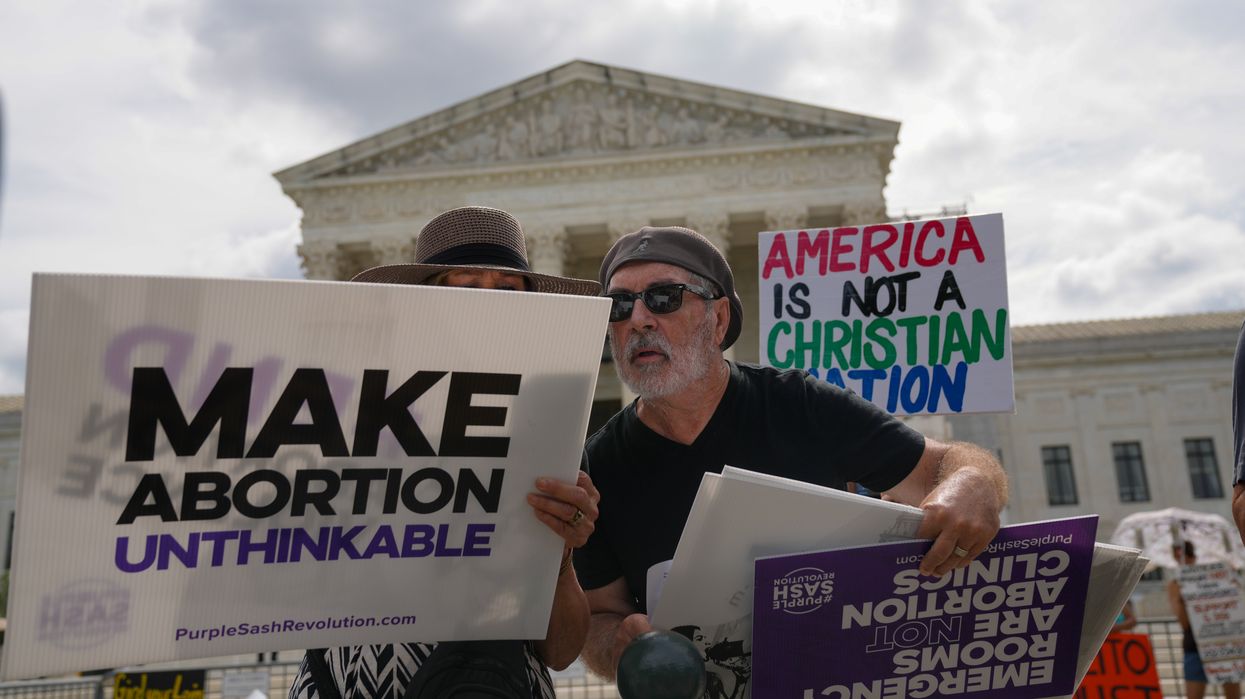Leven is a policy consultant specializing in democracy and state and local government reform. She leverages her practical policy experience to deliver nonpartisan analysis through "This Week in Abortion," a newsletter featuring insightful reads, news updates, original analysis, and more.
Although we are divided, most Americans believe that some access to abortion should be guaranteed. This includes a majority of Republicans, who, since 1975, have agreed that there should be legal access to abortion under certain circumstances.
Project 2025, the Heritage Foundation’s blueprint for a second Trump administration, disagrees. “Abortion,” the plan says, “is not health care.” It takes this already extreme position further by constantly defining life as starting at conception. We’re talking egg-meets-sperm conception. By this definition, standard in vitro fertilization would be illegal as would some forms of birth control.
“Eliminate the week-after-pill from the contraceptive mandate as a potential abortifacient. One of the emergency contraceptives covered under the HRSA preventive services guidelines is Ella (ulipristal acetate). Like its close cousin, the abortion pill mifepristone, Ella is a progesterone blocker and can prevent a recently fertilized embryo from implanting in a woman’s uterus. HRSA should eliminate this potential abortifacient from the contraceptive mandate.”
This is not surprising. The list of advisors and authors involved with Project 2025 is a who's who of the anti-abortion movement. What is shocking is how this extreme idea is embraced as a cornerstone of U.S. domestic and international policy, undermining our democracy in the process.
Let’s start with the Department of Health and Human Services. The plan prescribes an unprecedented shift in focus. As their number one goal, the plan says, “The Secretary must ensure that all HHS programs and activities are rooted in a deep respect for innocent human life from day one (conception).”
The Centers for Disease Control and Prevention would fund politically-motivated research [2] that assumes any interruption of pregnancy after conception is bad for your bodily and mental health. It would also promote fertility awareness-based methods (FABMs) for birth control. The plan returns to this idea across HHS services, claiming without even so much as a footnote that, “FABMs are highly effective” at preventing pregnancy.
“The CDC should eliminate programs and projects that do not respect human life and conscience rights and that undermine family formation. It should ensure that it is not promoting abortion as health care. It should fund studies into the risks and complications of abortion and ensure that it corrects and does not promote misinformation regarding the comparative health and psychological benefits of childbirth versus the health and psychological risks of intentionally taking a human life through abortion.”
There is a method to this madness. Under threat of funding cuts, the CDC would require detailed reporting on abortion from every state. Combined with the personal information it could collect from period-tracking apps (see FABM) and the repeal of guidance that clarifies abortion related-care is protected private health information, the plan is laying the groundwork for a citizen surveillance network.
“Data Collection. The CDC’s abortion surveillance and maternity mortality reporting systems are woefully inadequate. CDC abortion data are reported by states on a voluntary basis, and California, Maryland, and New Hampshire do not submit abortion data at all. Accurate and reliable statistical data about abortion, abortion survivors, and abortion-related maternal deaths are essential to timely, reliable public health and policy analysis.
“Because liberal states have now become sanctuaries for abortion tourism, HHS should use every available tool, including the cutting of funds, to ensure that every state reports exactly how many abortions take place within its borders, at what gestational age of the child, for what reason, the mother’s state of residence, and by what method. It should also ensure that statistics are separated by category: spontaneous miscarriage; treatments that incidentally result in the death of a child (such as chemotherapy); stillbirths; and induced abortion. In addition, CDC should require monitoring and reporting for complications due to abortion and every instance of children being born alive after an abortion. Moreover, abortion should be clearly defined as only those procedures that intentionally end an unborn child’s life. Miscarriage management or standard ectopic pregnancy treatments should never be conflated with abortion.”
The plan further calls for the National Institutes of Health and the Food and Drug Administration to adopt explicitly anti-abortion biases. It says the NIH should “promote a research agenda that supports pro-life policies.” It calls on the FDA to rescind the decades-old approval of abortion pills, with language that grossly misrepresents the actual scientific facts.
“Since its approval more than 20 years ago, mifepristone has been associated with 26 deaths of pregnant mothers, over a thousand hospitalizations, and thousands more adverse events, but that number does not account for all complications. Of course, this does not count the hundreds of thousands to millions of babies whose lives have been unjustly taken through chemical abortion.”
I have only covered a tiny piece of the anti-abortion policies the department would push if it follows Project 2025, but HHS is far from the only place this agenda reaches. Let’s talk foreign policy.
The plan proposes making respect for “authentic human rights (including the belief that conception is life) a litmus test of personnel decisions” within the State Department, and prioritizes similar moves at USAID through Schedule F. It also suggests the president reconsider America’s participation in every international organization using this same lens, while building up a coalition of countries under the “ Geneva Consensus Declaration,” a regressive anti-abortion manifesto created under the Trump administration. There are currently 36 signatories to the declaration. Not one of our top 15 trading partners (75 percent of overall trade) has signed on. Instead, the list includes Russia along with Libya, Sudan and the Democratic Republic of Congo, three of the 15 worst-rated countries on The Economist’s Democracy Index.
The next Administration should direct the Secretary of State to initiate acomprehensive cost-benefit analysis of U.S. participation in all internationalorganizations. This review should take into account long-standing provisions infederal law that prohibit the use of taxpayer dollars to promote abortion,population control, and terrorist activities, as well as other applicable restrictionson funding for international organizations and agencies with a view to withholdingU.S. funds in cases of abuses. (191)
The U.S. government should not and cannot promote or fund abortion ininternational programs or multilateral organizations. Technically, the UnitedStates can prevent its international funding from going toward abortions, but theU.S. will have a greater impact by including like-minded nations and building onthe coalition launched through the Geneva Consensus Declaration, with a view toshaping the work of international agencies by functioning as a united front. (192)
Under the plan, we may come to look more like these authoritarian friends. The Justice Department and the Federal Bureau of Investigation, having been stripped of any independence, would be called on to enthusiastically enforce the Comstock Act. Using a politicized interpretation, the plan argues this act can be used to shut down access to abortion. If states don’t want to expend their resources participating in this interpretation, the FBI would be empowered to increase its presence on the ground, and the DOJ could take legal action against local officials.
Enhancing the Federal Focus on and Resources in Jurisdictions with Rule-of-Law Deficiencies. A disturbing number of state and local jurisdictions have enacted policies that directly undermine public safety, leave doubt about whether criminals will be punished, and weaken the rule of law. While the prosecution of criminal offenses in most jurisdictions across the country must remain the responsibility of state and local governments, the federal government owes a special responsibility to Americans in jurisdictions where state and local prosecutors have abdicated this duty…
Use applicable federal laws to bring federal charges against criminals when local jurisdictions wrongfully allow them to evade responsibility for their conduct. The department should also increase the federal law enforcement presence in such jurisdictions and explore innovative solutions to bring meaningful charges against criminals and criminal organizations in such jurisdictions.
Where warranted and proper under federal law, initiate legal action againstlocal officials—including District Attorneys—who deny American citizensthe “equal protection of the laws” by refusing to prosecute criminal offenses in their jurisdictions. This holds true particularly for jurisdictions that refuse to enforce the law against criminals based on the Left’s favored defining characteristics of the would-be offender (race, so-called gender identity, sexual orientation, etc.) or other political considerations (e.g., immigration status).(553)
Fighting abortion without resorting to authoritarianism is possible. However, this plan isn’t happy relying on Congress to make laws and isn’t stopping with undoing some executive orders. Under this plan the United States government becomes a conception-is-life propaganda machine. It uses taxpayer money to intentionally discredit the expertise and integrity of our scientific agencies, threatens strategic international collaboration and alliances over an extremist moral ideal, and makes a loyalty and morality test the first requirement for public service. All this while potentially building a system to monitor the details of our private lives.
We are probably not going to wake up tomorrow in “The Handmaid's Tale.” But this plan represents a decisive movement away from the liberty and the democracy that is the promise of America, towards as the plan says, the Conservative “promise to America” in which a centralized tribalistic elite are not serving the people, but rather are engineering the country to fit their purpose and ideals.
More articles about Project 2025
- A cross-partisan approach
- An Introduction
- Rumors of Project 2025’s Demise are Greatly Exaggerated
- Department of Education
- Managing the bureaucracy
- Department of Defense
- Department of Energy
- The Environmental Protection Agency
- Education Savings Accounts
- Department of Veterans Affairs
- The Department of Homeland Security
- U.S. Agency for International Development
- Affirmative action
- A federal Parents' Bill of Rights
- Department of Labor
- Intelligence community
- Department of State
- Department of the Interior
- Federal Communications Commission
- A perspective from Europe
- Department of Health and Human Services
- Voting Rights Act
- Another look at the Federal Communications Commission



















 On Jan. 6, 2021, a political rally turned into an insurrection as
On Jan. 6, 2021, a political rally turned into an insurrection as  Michelle Witthoeft, Ashli Babbitt’s mother, participates in a demonstration in support of insurrectionists who were arrested and charged following the January 6, 2021 attack on the U.S. Capitol. (Tasos Katopodis/Getty Images)
Michelle Witthoeft, Ashli Babbitt’s mother, participates in a demonstration in support of insurrectionists who were arrested and charged following the January 6, 2021 attack on the U.S. Capitol. (Tasos Katopodis/Getty Images)
